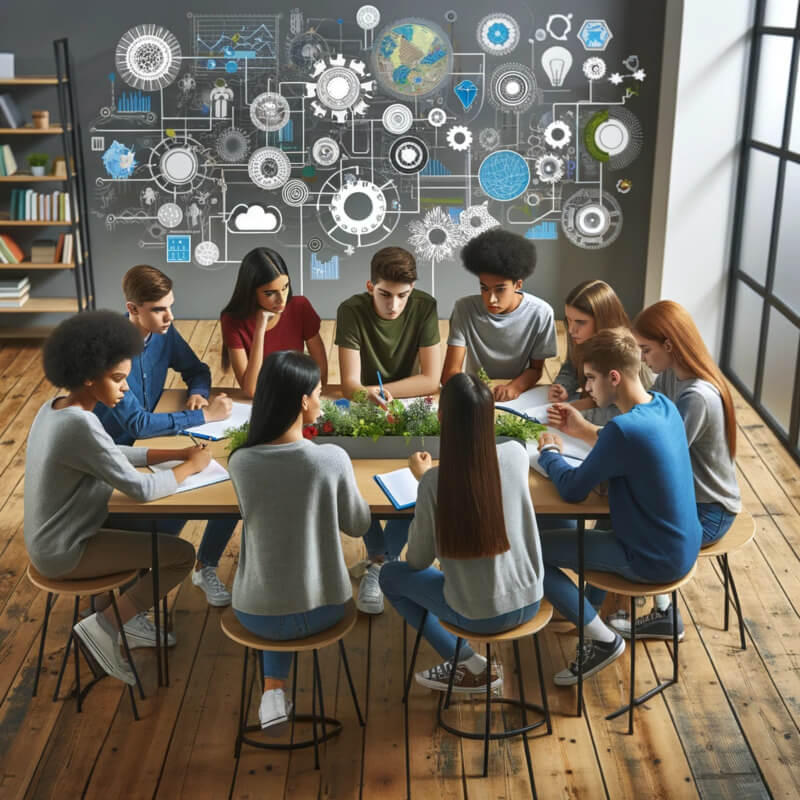Social justice is an expansive and dynamic concept grounded in the idea of fairness and equity within society. It’s about creating a world where the distribution of resources is equitable and all members of society have equal opportunities for participation, regardless of their background or circumstances. This concept extends beyond mere legal equality to encompass a deeper, more substantive form of equality – a commitment to societal balance where everyone is afforded the same chances for success and recognition.
In contemporary society the importance of public fairness cannot be overstated, It stands as a crucial pillar in the pursuit of a harmonious and progressive world. In an era marked by rapid globalization and increasing awareness of systemic inequalities, communal justice emerges as a beacon of hope and a guidepost for policy-making and communal reform.
It challenges us to look beyond our individual experiences and consider the collective well-being, advocating for policies and practices that dismantle barriers and promote inclusivity. At its essence, communal justice is about shaping a society that values and nurtures every individual, recognizing the inherent worth and potential of each person.

Exploring Different Types of Social Justice
Societal fairness – a multifaceted concept rooted in the pursuit of fairness and equality, branches into various forms, each addressing unique aspects of societal balance. Here we delve into the different types of societal justice, unraveling their complexities and understanding their significance today.
- Economic Justice: At the heart of economic fairness lies the principle of equitable distribution of resources. It challenges income disparities, strives for fair employment opportunities, and advocates for a living wage. This aspect of communal justice ensures that everyone has access to economic resources necessary for a dignified life.
- Racial Justice: This form addresses systemic racism and discrimination. It seeks to dismantle barriers erected by prejudice and historical injustices, striving for a society where one’s race or ethnicity is not a determinant of their life chances or treatment.
- Gender Justice: Central to gender fairness is the fight against gender-based discrimination. It encompasses efforts to break down patriarchal structures, promote gender equality in all spheres of life, and support the rights of all genders.
- Environmental Justice: Often overlooked, environmental fairness focuses on the fair treatment of all people regardless of race, color, national origin, or income with respect to environmental laws, regulations, and policies. It recognizes that marginalized communities often bear the brunt of environmental hazards.
- Social Justice in Healthcare: This type emphasizes equal access to medical services and health education. It tackles disparities in healthcare based on socioeconomic factors, ensuring that everyone, regardless of their background, receives adequate healthcare.
- Educational Justice: Advocates for educational fairness strive to provide equal access to quality education for all, addressing disparities that arise from socioeconomic status, race, or geographical location.
Each of these types interweaves with the others, illustrating the complexity of achieving true communal justice. They remind us that our pursuit of a fair society is multifaceted, requiring dedication across various fronts. In understanding and advocating for these different types, we step closer to a world where fairness is not just an ideal, but a reality for all.
Social Justice in Theory and Practice
Social justice, a term that resonates with profound significance in both academic discourse and everyday conversation, embodies a pursuit of fairness and equity within society. Theoretical frameworks of communal fairness delve into the philosophical underpinnings of what it means to live in a just society. In practice, these theories transform into tangible actions and policies aimed at redressing inequalities and fostering inclusivity.
As philosopher and social critic Michael Walzer insightfully remarked,
“Social justice is the art of achieving a balance between individual liberty and social equality.”
This delicate balancing act underscores the interplay between personal freedoms and communal responsibilities.

In theory, communal justice seeks to define fair and just relationships between the individual and society. It encompasses a range of topics from economic distribution to rights and responsibilities. The definition of societal fairness theory extends beyond textbook explanations, evolving with societal changes and reflecting contemporary issues.
Practically, social equity manifests in various forms: from grassroots activism advocating for policy changes to educational reforms aimed at equalizing opportunities. It involves not only recognizing the inherent dignity of every individual but also actively working towards a society that supports and uplifts its members.
Social equity in practice is about transforming theoretical ideals into reality. It’s about challenging the status quo, questioning ingrained biases, and tirelessly working towards a world where equality isn’t just an ideal, but a lived experience for all. This journey from theory to practice isn’t linear or straightforward; it’s complex, challenging, and continuously evolving. But, it’s a journey worth undertaking for the betterment of society as a whole.
Social Justice in Education: A Crucial Conversation
Have you ever pondered how the principles of communal fairness manifest within the walls of our educational institutions? Societal equity in education isn’t just a theoretical concept; it’s a vital, ongoing conversation about how we create equitable learning environments for all students.
The essence of social justice theory in education lies in addressing and dismantling the systemic barriers that hinder equal access to learning. It’s about recognizing and valuing diverse perspectives, ensuring that every student, irrespective of their background, has the same opportunity to thrive. In practice, this means creating curriculums that are inclusive, implementing policies that actively combat discrimination, and fostering an environment where every voice is heard and valued.
Consider the case of the ‘Harmony Schools’ initiative, a pioneering program introduced in several U.S. cities. These schools focus on inclusivity and cultural competence, integrating social fairness into their curriculum by teaching students about civil rights, societal movements, and global citizenship. As a result, students from diverse backgrounds feel seen, heard, and included, leading to a more cohesive learning environment.
Another example is the implementation of ‘restorative justice’ in schools. This approach, which focuses on repairing harm and restoring relationships rather than punitive measures, has been transformative. It encourages students to understand the impact of their actions, fosters empathy, and promotes a more supportive school community.

The key to successful integration of social fairness in education is understanding that it’s not a one-size-fits-all approach. It requires ongoing dialogue, a willingness to listen, and a commitment to continuous improvement. By incorporating social justice theories into the educational framework, we’re not just educating minds; we’re nurturing compassionate, socially aware citizens of the future.
Remember, societal equity in education is an essential conversation, one that asks us to look beyond traditional teaching methods and embrace a more holistic, inclusive approach. It’s about creating an educational landscape where every student, regardless of their background, can flourish.
Healthcare and Social Justice: Ensuring Equity for All
Bridging the Healthcare Divide
Imagine a world where healthcare is a lush, expansive garden. In this garden, every plant, regardless of its origin, has access to sunlight, water, and nutrients – essential elements for growth and survival. This is the vision of healthcare under the lens of societal fairness: a system where every individual, irrespective of their socioeconomic status, race, or geography, has equal access to health services.
The Core of Social Justice in Healthcare
At the heart of societal fairness theory in health care lies the commitment to eliminate disparities and create an equitable healthcare landscape. This commitment is akin to ensuring that every patient, like every plant in our garden, gets the care tailored to their specific needs and circumstances. It’s about recognizing that a one-size-fits-all approach is as ineffective in healthcare as it would be in gardening.
Case Studies: Turning Theory into Practice
Consider the implementation of community health initiatives in underserved areas. These programs are like rainwater harvesting systems in our garden analogy, specifically designed to provide nourishment to areas that receive less rainfall. By targeting communities that traditionally lack access to healthcare, these initiatives work towards balancing the scales of healthcare equity.
Another example is the integration of mental health services into primary healthcare settings. This approach acknowledges that mental health is as crucial to overall well-being as physical health, similar to how both sunlight and water are essential for a plant’s growth.
Toward a Healthier Future
The journey towards equitable healthcare is ongoing. It involves continually assessing and addressing the unique healthcare needs of diverse populations. Just as a gardener must be attentive to the changing needs of their garden, healthcare providers and policymakers must remain responsive to the evolving healthcare landscape.
In conclusion, social equity in healthcare is not just a theoretical concept; it’s a vital, actionable commitment to ensuring that every individual has the opportunity to lead a healthy life. It’s a pledge to nurture the garden of healthcare so that every person, every plant, can thrive.
Challenges and Future Directions
As we stand at the crossroads of progress and tradition in social equity, the path ahead is shrouded with both challenges and promises. What obstacles must we overcome, and what new horizons are we to explore?
- Overcoming Systemic Barriers: The deeply rooted systemic inequalities in our society pose significant challenges. From institutional racism to gender bias, these entrenched barriers require concerted efforts to dismantle. The task ahead is not just to identify these issues but to actively work towards creating systems that are inherently equitable.
- Technological Advancements and Privacy Concerns: With the rise of digital technology, the landscape of social fairness is changing rapidly. While technology offers novel solutions to old problems, it also raises concerns about privacy and digital divides. The challenge lies in leveraging technology for societal good while safeguarding individual rights.
- Globalization and Cultural Sensitivity: In an increasingly interconnected world, social equity takes on a global dimension. This brings forth the challenge of understanding and respecting cultural differences while promoting universal human rights. Navigating this delicate balance will be crucial for future societal fairness initiatives.
- Sustainable Development Goals (SDGs): The United Nations’ SDGs offer a blueprint for global development that is sustainable and equitable. The challenge for societal equity advocates is to align their efforts with these goals, ensuring that social progress does not come at the expense of environmental or economic stability.
Looking ahead, the landscape of social equity is one of dynamic change and hopeful possibilities. The journey will be arduous, but the destination — a world where fairness and equality are not just ideals but realities — is worth every effort.

The Role of Psychology in Social Justice
In the intricate dance of societal fairness, psychology plays a pivotal role, offering insights into the human condition that are essential for fostering a more equitable society. It is the lens through which we understand the impacts of injustice on the human psyche and the catalyst that drives us towards compassionate action.
Psychology provides the tools to decode the complexities of human behavior, unraveling the threads of bias, prejudice, and systemic inequality. It guides us in crafting interventions that not only address the symptoms of social injustice but also its deep-rooted causes. By understanding the psychological underpinnings of societal issues, we can create strategies that resonate on a personal level, driving meaningful change.
As we reflect on the journey towards a just society, one question lingers: How can we harness the power of psychology not just to understand societal injustice, but to actively dismantle it and build a world that uplifts every individual? The answer to this question shapes the future of social fairness.
These may interest you:
